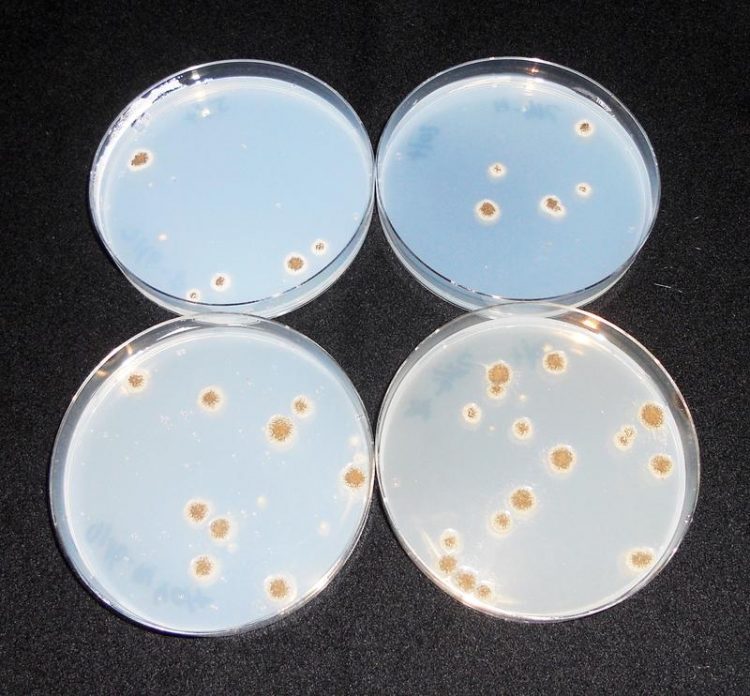Switching mutations on and off again

The more Doxycycline is added, the more active the mobile genetic element becomes, and the number of mutant colonies rises. Photo: Prof. Frank Kempken
Mould is primarily associated with various health risks. However, it also plays a lesser-known role, but one which is particularly important in biotechnology. The mould (ascomycete) Aspergillus niger, for example, has been used for for around 100 years to industrially produce citric acid, which is used as a preservative additive in many foodstuffs.
In order to research the genetic mechanisms which could shed light on the potential application spectrum of mould and its metabolic products, a research team from Kiel University has developed a new procedure in collaboration with colleagues from Leiden University in the Netherlands.
It allows the rapid production of a large number of genetic variations of the mould Aspergillus niger, and the subsequent specification of the resulting genetic attributes. The research team led by Professor Frank Kempken, head of the Department of Genetics and Molecular Biology at Kiel University and member of the research focus “Kiel Life Science”, published their new findings in the scientific journal Applied Microbiology and Biotechnology.
Biotechnological research makes use of genetically-modified model organisms, also known as mutants, in order to determine the functions of specific genes. Scientists refer to this as functional genomics. One of the procedures used for this is known as random mutagenesis. It scrambles the genetic information, and thereby produces different clones of an organism. The analysis of the varying attributes then allows conclusions to be drawn of the effects of specific genes.
In this context, the Kiel research team focussed on a line of the ascomycete Aspergillus niger, which is widely used in scientific research. It is characterised by the fact that one of the mobile genetic elements involved in the creation of mutations, known as Tan/Vader, is permanently non-functional, and can therefore not create mutations. Experiments conducted by the research team have resulted in a breakthrough, enabling an on/off switchable variant of this mobile element to be introduced to Aspergillus niger. Through the addition of an antibiotic substance known as Doxycycline, Tan/Vader can be switched on and then create mutants. When the research team did not add the substance again, the mobile element became inactive once more.
The switching on and off of the mobile element Tan/Vader thereby enables the production either of quickly and randomly mutating lines, or genetically stable lines of the mould. The behaviour of the mould lines in terms of their tendency to mutate can therefore be precisely controlled. “The new procedure allows us to create a large amount of modified mould in a short time, in order to subsequently investigate their attributes. These findings are of major significance for researching the genetic repertoire of Aspergillus niger with respect to its biotechnological potential,” said Kempken on the impact of the new research.
Filamentous moulds such as Aspergillus niger are extensively researched in biotechnology, particularly due to their ability to form complex enzymes. Such enzymes then form the basis of various applications, for example in food production or the development of new medicines. The latest results from the Kiel research team provide the scientific community with a new tool to facilitate such research in future.
Photos are available to download:
http://www.uni-kiel.de/download/pm/2016/2016-097-1.jpg
The more Doxycycline is added, the more active the mobile genetic element becomes, and the number of mutant colonies rises.
Photo: Prof. Frank Kempken
Original publication:
Paun, L., Nitsche, B., Homan, T., Ram, A.F. and F. Kempken (2016): An inducible tool for random mutagenesis in Aspergillus niger based on the transposon Vader.
Applied Microbiology and Biotechnology
Link: http://dx.doi.org/10.1007%2Fs00253-016-7438-3
Contact:
Prof. Frank Kempken
Department of Genetics and Molecular Biology
Botanical Institute and Botanical Gardens, Kiel University
Tel.: +49 (0)431-880-4274
E-mail: fkempken@bot.uni-kiel.de
More information:
Department of Genetics and Molecular Biology
Botanical Institute and Botanical Gardens, Kiel University
http://www.uni-kiel.de/Botanik/Kempken/fbkem.shtml
Research focus “Kiel Life Science“, Kiel University
http://www.kls.uni-kiel.de
Christian-Albrechts-Universität zu Kiel
Press, Communication and Marketing, Dr Boris Pawlowski, Text: Christian Urban
Postal address: D-24098 Kiel, Germany, Telephone: +49 (0)431 880-2104, Fax: +49 (0)431 880-1355
E-mail: presse@uv.uni-kiel.de, Internet: www.uni-kiel.de
Twitter: www.twitter.com/kieluni, Facebook: www.facebook.com/kieluni
Media Contact
All latest news from the category: Life Sciences and Chemistry
Articles and reports from the Life Sciences and chemistry area deal with applied and basic research into modern biology, chemistry and human medicine.
Valuable information can be found on a range of life sciences fields including bacteriology, biochemistry, bionics, bioinformatics, biophysics, biotechnology, genetics, geobotany, human biology, marine biology, microbiology, molecular biology, cellular biology, zoology, bioinorganic chemistry, microchemistry and environmental chemistry.
Newest articles

NASA: Mystery of life’s handedness deepens
The mystery of why life uses molecules with specific orientations has deepened with a NASA-funded discovery that RNA — a key molecule thought to have potentially held the instructions for…

What are the effects of historic lithium mining on water quality?
Study reveals low levels of common contaminants but high levels of other elements in waters associated with an abandoned lithium mine. Lithium ore and mining waste from a historic lithium…

Quantum-inspired design boosts efficiency of heat-to-electricity conversion
Rice engineers take unconventional route to improving thermophotovoltaic systems. Researchers at Rice University have found a new way to improve a key element of thermophotovoltaic (TPV) systems, which convert heat…



